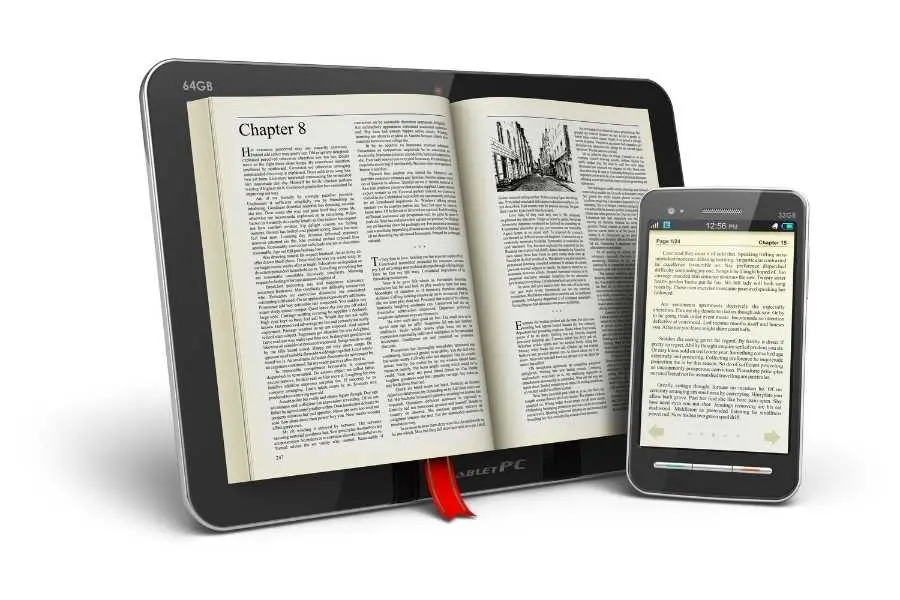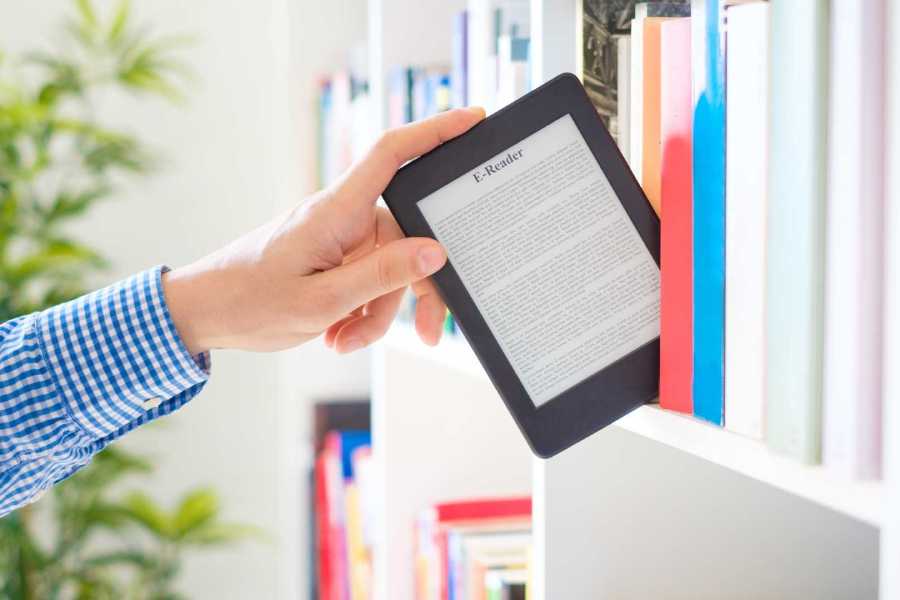There is an ongoing debate between readers who love printed books and those who prefer electronic books, or e-books.
Some of their best arguments are how the light from mobile devices can harm your eyes or how unecological it is to extract paper and transport printed books.
Who is right? Which is best, the printed book or the e-book? We consulted specialists on books and humanities from Tec de Monterrey, as well as print and digital publishers and librarians.

The pandemic and the boom in e-books
There was a boom in e-commerce and e-book sales during the pandemic. The Module on Reading (MOLEC) from the National Institute of Statistics and Geography (INEGI), which has documented the e-book phenomenon from 2016 to 2022, reports growth of 16 percentage points.
This means that more than 30% of Mexican readers currently read in some kind of digital format.
For Norma Rufrancos, Digital Marketing Manager at Grupo Planeta Mexico, United States, and Central America, e-books have broken boundaries that print could not.
“Printing, exporting, and distributing is costly. E-books don’t have territorial boundaries. We have books from other countries that don’t physically exist in Mexico because they can’t be imported or it’s very expensive to do so,” she says.
Rufrancos believes this is one of the main advantages that led to e-books gaining ground during the pandemic.
What’s more, during the health emergency, “e-books won because of their immediacy: you just click, purchase, and there they are. You don’t have to wait for them to be delivered,” she points out.
For instance, if you hear about an interesting title in a conversation, class, or program, you can look it up and start reading instantly. You don’t have to go to the bookstore.

Also extolling the virtues of e-reading is Alejandra González Barranco, leader of Digital Publishing at Tec de Monterrey, who mentions other advantages:
“You don’t need to keep e-books in stock. You don’t run out of them. As long as they have the rights and the technology, libraries or bookstores can let thousands of people access one copy without having to wait for another user to finish reading it.”
Another virtue of e-books is that you can take your entire library with you.
What’s more, González Barranco explains that e-books are more ecological. They don’t require paper or transportation, although the use of mobile devices always incurs a carbon footprint.
She also explains that upgrades have been developed to the technology for this text format that allow users to adjust the brightness and color of the pages so as not to harm their eyes; make annotations; and highlight sections.
Moreover, there is a large variety of authors, editions, and titles just a click away.
“You don’t need to keep e-books in stock. You don’t run out of them.” - Alejandra González, leader of Digital Publishing at the Tec
Challenges to overcome and opportunities for e-books
However, not everything about this reading format is perfect. One of its limitations is that not all Mexicans can access it.
3 out of every 10 people do not use the Internet and 2 out of every 10 Mexicans do not have a smartphone, according to the National Survey on Availability and Use of Information Technologies in Households (ENDUTIH) conducted by INEGI.
Another considerable challenge of e-books pointed out by the leader of Digital Publishing at Tec de Monterrey is that most electronic editions are no more than a clone of the printed version.
“Sometimes, e-books are just a PDF file,” admits González. “That’s why Tec de Monterrey has been working on enriching texts with resources to improve the reading experience since 2010.”
The specialist says that to be successful, e-books should contain a kind of playlist that emulates the atmosphere of a book with video, audio, and augmented reality to give it added value.
When also asked to imagine how e-books can form a bigger part of readers’ lives in future, Rufrancos from Grupo Planeta says she believes that cryptocurrencies could enrich e-books with previously unreleased and exclusive material in this format.

In defense of printed books
Those who prefer the traditional reading experience say that one of the aspects of physical texts most appreciated by readers is that of spatial memory.
“Paper gives you an idea of space. You can identify the paragraphs above and below, which helps your memory to locate the content and section where you saw something you were interested in,” explains Inés Sáenz, Vice President of Inclusion, Social Impact, and Sustainability at the Tec.
Marcela Beltrán, Director of Special Collections at Tec de Monterrey, concurs and adds: “You retain the sensation of turning the pages. You remember more things. You remember how you felt when you were reading.”
Furthermore, books are a truly cultural symbol, believes José Manuel Suárez Noriega, leader of the Passion for Reading program in the Mexico City region and professor at the Tec’s School of Humanities and Education.
“We see printed books as something material, as a symbol of the culture, as an opportunity to hold the manuscript and say, ‘This is literature,’ while we associate e-books with data.”

The expert adds that books form part of a human weakness: they are collectible objects.
“We human beings are fetishists by nature, and we love collecting things. We admire the different editions, make notes in the margin, and get them signed by our favorite authors,” he explains.
In fact, books as objects confer cultured status on their bearers. They are objects that validate us as readers.
“Books have survived throughout all this time, from the invention of the printing press until now. They’re instruments that aren’t going to disappear,” says Ana Luisa Macías, National Director of Cultural Heritage at Tec de Monterrey.
The specialists reel off other advantages, such as being able to read without needing a device that runs on batteries, you can better appreciate the illustrations, and they provide sensations such as being able to smell the aroma of printed paper.
So, despite the accelerated growth in e-books, printed books continue to be very popular: in Mexico, 7 out of every 10 readers prefer paper, according to MOLEC 2022 from INEGI.
"(Con el libro físico) te acuerdas de más cosas, de cómo te sentiste cuando leíste".- Marcela Beltrán, directora de Colecciones especiales del Tec
The limitations of one are the opportunities of another
Although books are an unbeatable invention and “have no real substitute” according to Inés Sáenz, they do have limitations.
Some of these include them taking up space, being heavy, not being available everywhere, and requiring paper, ink, and transportation to be distributed.
What’s more, they are costly to preserve, requiring special conditions to maintain them.
These are precisely the limitations that allow them to coexist with the digital format, admit the experts.
Consuelo Sáizar, General Director of the Monterrey International Book Fair (FIL) says that we are “a privileged generation, who can choose to read in different formats.”
She reiterates that we live at a time of freedom: if the book you want is out of stock at your bookstore, you can resort to e-commerce or e-books.

Readers can choose the format that best suits their needs, although the formats have become stronger in different areas.
This is according to José Vladimir Burgos Aguilar, National Director of Libraries at the Tec, who emphasizes that print is gaining ground in reading for pleasure, for works such as novels, classics, and poetry.
On the other hand, the digital format is gaining ground among academic, technical, and reference texts, he adds.
It also has to do with each reader’s tastes, says Daisy Adriana Arrieta, Library leader at the Tec’s Mexico City campus.
“Students of medicine, art, and architecture prefer printed editions because they need to see the illustrations in detail, but the library has a growing number of simulators that allow them to experience something which is closer to reality,” she explains.
So, the experts we consulted emphasize that we shouldn’t be thinking of 100% digital readers or 100% paper readers, but hybrid readers.
A glimpse of the libraries and bookstores of the future
Just as readers will be hybrid, so will libraries and bookstores. “Collections will grow as digital and print coexist and complement each other,” says Consuelo Sáizar.
“What we’re seeing is an evolution of multi-formats, which means the presence of printed or digital books; audio and video collections; and different resources in the metaverse and augmented reality,” says Vladimir Burgos, National Director of Libraries at the Tec.
Currently, Tecnológico de Monterrey’s library offers access to 4.1 million volumes in its physical and digital collections.
2.4 million of these correspond to physical material and 1.7 million to digital material. The collection consists of books, e-books, encyclopedias, videos, and journals in all areas of knowledge where the institution offers academic programs.
Marcela Beltrán believes that paper will never disappear, but the books we consume on paper will change.
“I think we’re going to become a society that reads more, but we’ll consume shorter printed works with more graphical elements, such as illustrations and art,” Beltrán explains.
However, one point on which all the specialists agree is that the bond forged between human beings and the word will not be broken, regardless of the format.
READ MORE:





